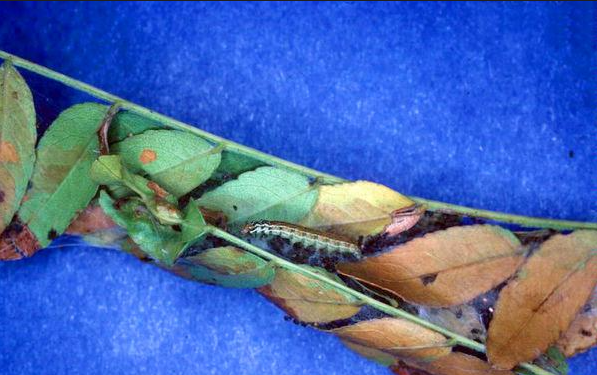| DEFOLIATING insects in CO- if left uncontrolled, will kill the trees |
 |
| Written by Colorado Green Now |
| Wednesday, August 21, 2024 12:00 AM |
|
Rare insects are now being spotted in Colorado 1. Mimosa Webworm - Mature caterpillars are up to 1 inch (25 mm) long, grayish to dark brown and have five white stripes running the length of the body. During summer, large loose tents produced by the fall webworm (Hyphantria cunea) are seen on the branches of cottonwoods, chokecherry, and many other plants. Occasionally early spring outbreaks of caterpillars of the tiger moth (Lophocampa species) attract attention. Four species of tent caterpillars occur in Colorado.
2. Douglas fir Tussock Moth - In Colorado, isolated outbreaks tend to be cyclic in nature and may occur in intervals of seven to 10 years across the state. Adult male moths are a non-descript, gray-brown moths with feathery antennae and a wingspread of 1-1 1/4 inches (25-32 mm). The female is flightless and notably different from the male in that it has rudimentary wings and a large abdomen, usually about 3/4 inch (19 mm) long. Young larvae possess fine hairs; older larvae have two tufts behind the head, one posterior tuft, and four dense tussocks located along the back. Larvae grow up to 1 1/4 inches (32 mm). Eggs are laid in a mass on top of the cocoon from which the female moth emerges.
Control of both insects is relatively easy. However, they produce hundreds of eggs and can spread quickly! Homadaula anisocentra, also known as the mimosa webworm, is a species of moth in the family Galacticidae. It is considered a pest of ornamental plants. They attack the leaves of mimosa and honey locust. This species was introduced into the United States from China in the 1940s. Mimosa webworms attack both mimosa and honey locust trees. Widespread use of thornless honey locusts as ornamentals has heightened interest in the control of this insect because all varieties of the tree are susceptible to attack. Damage is done by webworm caterpillars, which web foliage together and skeletonize leaflets. The insect has two generations each year. However, injury is most noticeable by August when second-generation larvae are at the peak of activity. Continued feeding may cause infested trees to turn brown as if scorched by fire. DESCRIPTION AND LIFE HISTORY Adult mimosa webworms are small, silvery-gray moths which have wings stippled with black dots. Moths of the first generation appear in early June, while those of the second generation are seen in late July and early August. Adults lay eggs on foliage and in old webbing. Eggs are tiny, oval, and at first pearly-white, but turn pink as hatching time nears. Full-grown caterpillars are about 1 inch long and grayish brown in color with five lime green stripes running lengthwise down the body. They have a dark head, and the body is sometimes tinged with pink. First-generation caterpillars spin their cocoons between the folded leaves that they have webbed together. Second-generation caterpillars leave the tree canopy to find a site where they can spend the winter in cocoons protected from cold temperatures. In urban areas, this is often on tree trunks near buildings and paved areas or on the buildings themselves. The white cocoons resemble puffed rice and are often found in groups. SUSCEPTIBILITY OF HONEYLOCUST Due to their inability to survive cold temperatures, mimosa webworm tends to be a problem in urban areas. Of all thornless honey locust clones, Sunburst seems to be the most susceptible to webworm attack. Other varieties including Shade master, Skyline, Moraine and Imperial are less susceptible but still subject to severe injury. Mass plantings of ANY of the thornless varieties should be avoided unless the trees can be sprayed. CONTROL RECOMMENDATIONS In the absence of pesticide use, mimosa webworm problems occur in sheltered urban areas or along roadsides. The many insects and birds that feed on the caterpillars are likely to prevent the injury from harming tree health. To prevent unsightly amounts of webbing, trees can be sprayed with insecticides that target young caterpillars in mid-late June and in late July to early August.
The Douglas-fir tussock moth is a common defoliator of Douglas-fir and true firs. Hosts—In forested settings, the Douglas-fir tussock moth prefers Douglas fir. It is also occasionally found on true firs or spruce. Forest infestations can be intense, and other species of conifers surrounding Douglas-fir trees are often also defoliated. In urban settings, blue spruce is attacked. Urban infestations are often confined to individual trees, and the same trees may be attacked year after year, which can cause considerable damage or mortality. Life Cycle—Douglas-fir tussock moth has a 1-year life cycle and overwinters as eggs. Egg hatch coincides with bud burst. Larvae pass through four to six molts. Pupation occurs anytime from late July to the end of August inside a thin cocoon of silken webbing mixed with larval hairs. Adults appear from late July into November, depending on the location. The female moth emits a sex pheromone that attracts males. Damage—The first sign of attack appears in late spring as young larvae feed on current year’s foliage, causing it to shrivel and turn reddish brown. As larvae mature, they feed on older needles. Defoliation occurs first at tops of trees and outer branches and then, as the season progresses, on lower crowns and inner branches of the host tree. During a severe defoliation event, trees will appear as skeletons once the damaged needles have fallen off, and cocoons and egg masses will be visible year-round in the lower tree canopy. Damage from severe defoliation can lead to tree death or predispose trees to subsequent bark beetle attacks. Douglas-fir tussock moth can be one of the most damaging of western defoliators. Management—Natural controls, including predators, parasitoids, and a nuclear polyhedrosis virus (NPV), keep the tussock moth populations low most of the time. The natural controls, especially the NPV, also act to bring populations back under control during an outbreak. Douglas-fir tussock moth populations seem to follow a cyclical outbreak pattern, with outbreaks occurring every 8-12 years and lasting for 2-4 years. If applied control is desired, there are registered insecticides that might be used to reduce outbreak populations. The NPV has been made into a biocontrol (under the name TM-Biocontrol) and has been used in areas where rare Lepidoptera co-occurs with the tussock moth. The microbial pesticide Bacillus thuringiensis var. kurstaki (B.t.k.) is not hazardous to most beneficial insects, birds, small mammals, and aquatic systems. However, B.t.k. results against the tussock moth have not been consistent. Other contact chemical insecticides are also available for tussock moth management. Tussockosis—Hairs on the tussock moth larvae can cause an allergic reaction in humans. The most common reaction is skin irritation. Rashes, watery eyes, and sneezing are common symptoms. Avoid handling the larvae, and wash after exposure.
Read more in this issue of Colorado Green Now: |




